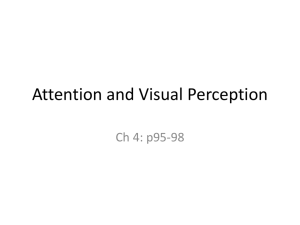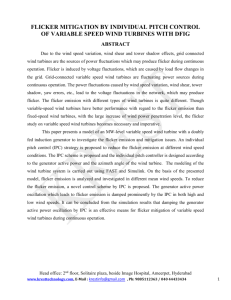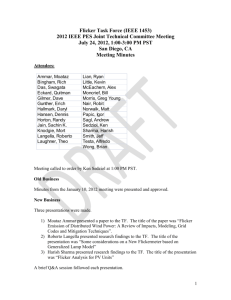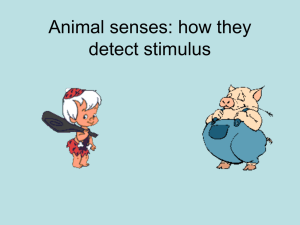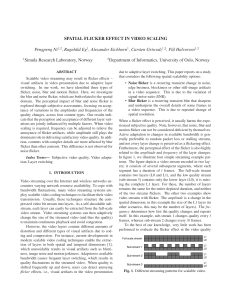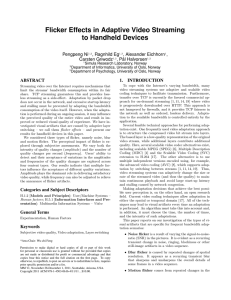Psychology paper - St. Francis Xavier University
advertisement
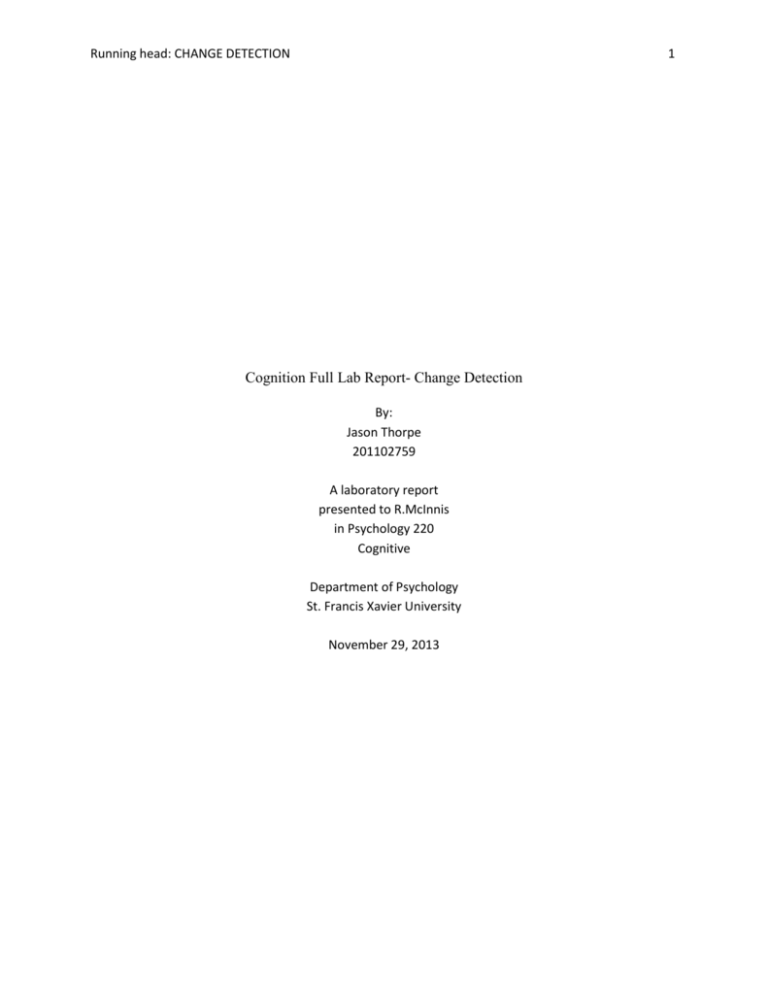
Running head: CHANGE DETECTION 1 Cognition Full Lab Report- Change Detection By: Jason Thorpe 201102759 A laboratory report presented to R.McInnis in Psychology 220 Cognitive Department of Psychology St. Francis Xavier University November 29, 2013 CHANGE DETECTION 2 Abstract The basis of this experiment was to demonstrate that the human brain struggles to detect change. Change detection is the process of depicting change from one sequence to the next. Forty-one Saint Francis Xavier undergraduate students were asked to complete the change detection experiment using Coglab. Participants were asked to analyze two photos to determine if a change occurred by giving a response. In the condition with no flicker, participants demonstrated a mean reaction time of 4537.945 milliseconds and were 0.958% correct. For the condition where a grey flicker occurred, participants demonstrated a mean reaction time of 7860.907 milliseconds and were 0.721% correct. In the end, we understand that humans suffer to detect change when a disruption occurs to the individual’s concentration and attention. CHANGE DETECTION 3 Cognition Full Lab Report- Change Detection Change detection is the process of identifying differences in an object by observing it at different times. The ability to detect change is an important aspect of our everyday life; examples include, noticing a person walking, seeing oncoming traffic, or watching a child play around the yard. The basis of this experiment was to demonstrate that the human brain struggles to detect change. Essentially it relies on attention and how concentrated you are in the changed area. If you know where the change is going to happen it is easy to distinguish. Studies have proven that detecting change is a challenging process and one that we humans struggle with. For example, observers tend to believe we could immediately detect any change in front of us if it was large enough (Levin et al. 2000). However, this is not so. Under a wide variety of conditions we can be blind to these changes even when they are significant. This situation is known as change blindness. To demonstrate this, experimenters created short motion pictures where objects were manipulated in the peripheral and the center of attention and observers failed to notice the change (Levin & Simons, 1997). Our current study was conducted to render a greater understanding of the human need for concentration and attention in order to detect change in an environment. Each subject reported to their cognitive psychology lab time to complete the change detection lab. Upon further discussion with the instructor subjects were instructed to proceed to cog lab in order to read the experiment debrief. Once comfortable with the instructions students were asked to complete the experiment during the designated time frame. On half of these trials, two pictures would be identical. On the other half of the trials, the two pictures differed in some way. It was up to the subject to determine wither a change occurred while trying to keep a short response time. The independent variable present in the experiment was wither there was a flicker CHANGE DETECTION 4 or no flicker. The second variable was if the pictures stayed the same or changed. The two dependent variables measured were the percentage of correct judgments and the overall response time. The expected result was that change detection in the non-flicker condition would be detected with a faster response rate in contrast to the flicker. It was also believed that fewer errors would occur in the non-flicker condition. Method Participants Forty-one Saint Francis Xavier undergraduate students were asked to complete the change detection experiment. The 41 male and female students came from a cognitive psychology class and ranged in age from 18-22. Apparatus To complete the experiment subjects were asked to log into a Mac desktop using their StFX domain name. Once logged in, subjects were instructed to log into CogLab where the change detection lab could be found. Method To begin the experiment, we asked participants to log into their CogLab account and find the change detection lab located under attention. Avoid using Internet Explore to allow the program to run smoothly. A total of 16 trials needed completion before terminal data can be included in the global results. If logged in correctly while on the proper experiment a black box should appear. Before beginning, only a short period is available to memorize the photo, they were asked for their best effort. The photo would either flicker or remain idol. The subject was then asked to decide if a change occurred or not. Once an answer was established two keys were CHANGE DETECTION 5 designated for the response. If a change did occurred subjects pressed the m-key as quickly as possible. If no change was noticeable the z-key was pressed. Once selected, the response was final and the next trial started by pressing the n-key. Once the 16 trials were completed the option to add the individual results to the global data pool is available. Results In the condition with no flicker, participants demonstrated a mean reaction time of 4537.945 milliseconds and a 0.958% correct. For the condition where a grey flicker occurred, participants demonstrated a mean reaction time of 7860.907 milliseconds and a 0.721% correct. Figure 1 illustrates the difference between reaction times of the two conditions while figure 2 shows difference in the percentage of correct answers for each condition. Furthering the investigation of the observed difference between conditions, t-tests were conducted. There was a considerable difference between the reaction times of the two conditions, t (38) = -6.52, p < .001 along with the proportion correct as well, t (38) = 8.61, p < .001. Table 1 Means and % correct based on data from 41 participants _________________________________________________ Proportion Correct RT (MS) _________________________________________________ Flicker 0.723 7825.238 No Flicker 0.960 4546.704 CHANGE DETECTION Figure 1. Mean reaction time score based on condition Figure 2. Percentage correct based on condition 6 CHANGE DETECTION 7 The original hypothesis was supported based on the data gathered throughout the experiment. By comparison of the means, it is noted that a faster reaction time occurred in the no flicker condition in contrast to the flicker. The proportion correct also reflected our original beliefs resulting in a greater percentage of correct responses in the no flicker condition. By stating this it’s understood that the flick which occurs has an impact on the overall results. Trying to depict the change is delayed by the flicker, therefore concentration and attention of the individual seems to be disrupted, delaying the overall response time. Individuals may believe that change detection only occurs in an experiment like this. As stated before, change blindness happens to most people and is when a person fails to detect change in their surrounding environment. A prime example is when an experimenter initiated a regular day conversation with a pedestrian. As the conversation grew the initial experimenter who started the conversation was replaced by his counterpart. One would be led to believe that as the conversation persisted one would recognize whom they are talking to. Against popular belief only fifty percent of the pedestrians recognized the change (Simons & Levin, 1998)! How can this be so? Humans have the ability to recognize tens of thousands of objects in our life time but individuals could not detect the simple change of the person to whom they were talking to. Experiments have shown that immediate memory for object identification is very poor (Simons, 1996). This provides us with somewhat of an idea about how this mistake could occur. To prevent this identification mistake it is advised to associate verbal cues towards the object to establish easier recognition. This allows us to understand how fifty percent of the individuals did recognize the experimenter swap. Knowing this we can have a greater understanding of how the human brain functions. Aspects such as concentration and attention are extremely important to live a safe life. A great CHANGE DETECTION 8 example of where this fails to occur is when drivers get behind the wheel impaired. Being impaired does not allow these drivers the ability to pay one hundred percent attention to the road and in the end it usually ends fatally. Knowing that humans struggle to detect change what does this mean for our future. The world is becoming increasingly technical on a daily basis with the basic understanding that it is making the daily life easier to live. There are individuals that deal with technology on a daily basis and without, their job would not exist. What if technology is making jobs increasingly dangerous with their recent developments? For example, airline commercial pilots are responsible for themselves but also the lives that reside on their air craft. Change must be detected and with the knowledge gained throughout this experiment it is understood that we cannot see it all. When looking at a dash board with over 200 gages help is needed and that is why auditory detection systems have been put into place. Though, where I see change detection being most critical is in the military. When looking out over the horizon in Afghanistan it would be nice to know if activity is occurring thirty kilometers down the road. The technological advancements in change detection not only allow this to happen but also save lives. In the end, detecting change is involved in everyone’s life. It is something that we must recognize to survive because without you might just get hit by a car. CHANGE DETECTION 9 References Levin , D. T., & Simons, D. J. (1997). Failure to detect changes to attended objects in motion pictures. psychonomic Bulletin and Review, (4), 501-506 Levin, D. T., Momen, N., Drivdahl, S. B., & Simons, D. J. (2000). Change blindness blindness: The metacognitive error of overestimating change-detection ability. Visual Cognition: Special Issue on Change Detection and Visual Memory, 7, 397-412. Simons, D. J. (1996). In sight, out of mind: When object representations fail. Psychological Science, (7), 301-305. Simons, D. J., & Levin, D. T. (1998). Failure to detect changes to people during a real-world interaction.Psychonomic Bulletin and Review, (5), 644-649.

